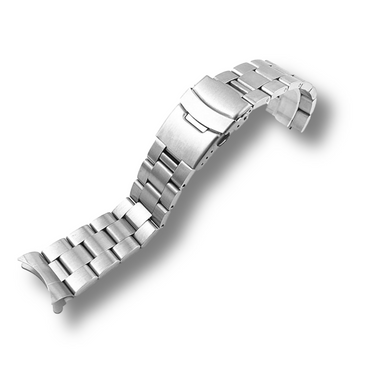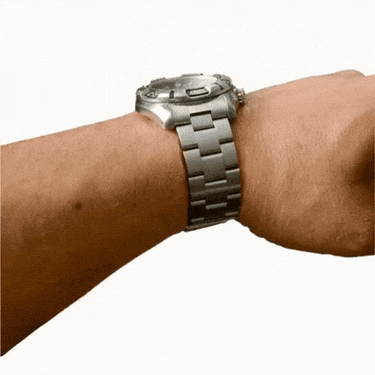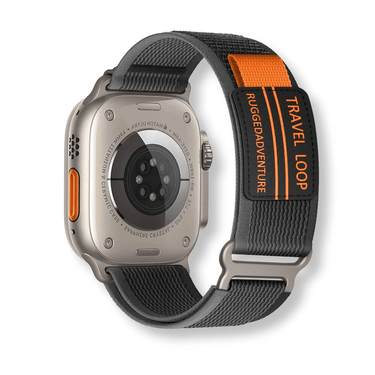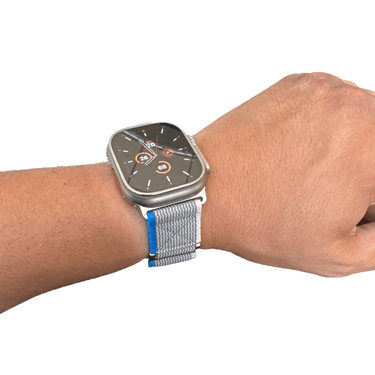Introduction
When it comes to underwater adventures, your safety and the accuracy of the equipment you use are paramount. As an avid diver myself, I know that having a reliable dive watchband with a depth gauge can make all the difference in the world. And let's be honest, who wouldn't want to explore the deep depths of our oceans without worrying about their equipment failing them?
But why is it so important to have a dive watchband with a depth gauge? At its core, a dive watchband is designed to measure time accurately and withstand high-pressure environments that come with diving under deep water.
A depth gauge, on the other hand, provides divers with vital information regarding their current depth which they need during their dives. It's for these reasons that we must take a closer look at some of the best dive watchbands available in today's market.
In this article, we'll delve into each brand's unique features and examine which materials work best for different types of activities. As you read through this article, keep in mind that these are my opinions based on years of experience as both an enthusiast and professional diver.
Why Accuracy Matters: Exploring Dive Watchbands with Depth Gauge
Imagine being underwater and realizing your current equipment is not providing accurate readings - downright scary right? That’s where dive watchbands with depth gauges come into play! When it comes to diving gear, accuracy matters more than anything else.
The last thing you want while exploring our vast oceans is inaccurate measurements or equipment failure. Dive watchbands provide divers with accurate measurements regarding how long they've been underwater while keeping track of their current depth levels as well.
While there are plenty of options available out there on the market today, not all brands offer what they claim. In this article, we will take an in-depth look at what makes the best dive watchbands with depth gauges stand out, so you can make an informed decision about which brand to choose for your underwater exploration.
Top Brands and Their Dive Watchband Features
Rolex, Omega, and Seiko are some of the most popular brands when it comes to dive watchbands. They've been trusted by divers all around the world for their accuracy, durability, and reliability. One of the standout features of Rolex's dive watchbands is their ability to withstand intense pressure environments.
With a strong emphasis on readability in low light situations, Rolex has committed itself to making sure that its users can have a clear reading even in the darkest parts of the ocean. Omega prides itself on producing dive watches with state-of-the-art technology.
Their depth gauges are some of the most accurate available today. They also offer features such as helium escape valves that allow divers to decompress properly after deep dives.
Seiko offers a range of dive watchbands featuring ultra-strong materials like titanium and stainless steel. They're designed for both professional and recreational divers alike who are looking for something that can take whatever they throw at it while offering accurate readings throughout their dives.
Niche Subtopics: Exploring Unique Features
While Rolex, Omega, and Seiko dominate the market in the realm of dive watchbands with depth gauges, there are other lesser-known brands worth considering as well. Some unique features offered by these brands include integrated compasses or temperature gauges built into their watches.
While these additional features might not be necessary for all types of diving activities or preferences they have proved beneficial in niche circumstances such as technical diving deployments where navigating through underwater caves is required. However, keep in mind that additional features may come at a higher cost; therefore it’s always best to carefully consider whether you truly need them before making a purchase decision.
Materials Matter: Examining Importance Of Materials Used In Dive Watchbands with Depth Gauge
Dive watchbands are made from a variety of materials, with each material offering its unique benefits and drawbacks. Rubber, silicone, stainless steel, and titanium are some of the most common materials used in dive watchbands. Rubber and silicone watchbands offer great flexibility and are comfortable to wear for long periods.
However, they can be prone to tearing off over time or when encountering sharp objects such as rocks. Stainless steel is a popular choice among divers because of its durability.
It doesn't bend or scratch easily, making it ideal for those who want to use their dive watches for years on end. Titanium takes things up a notch by being the strongest, most lightweight material available on the market today.
It's also corrosion-resistant and hypoallergenic - perfect for those with metal allergies. When it comes to choosing a dive watchband that fits your activity preference, understanding the materials used can make all the difference in ensuring you have equipment that lasts you for many dives to come!
The Basics: Understanding Dive Watchbands and Depth Gauge
What are Dive Watchbands?
Dive watchbands are a crucial accessory for any diver. They serve as a timekeeping device, but more importantly, they help track the depth and time spent underwater.
These watches come in various designs and styles, but they all share some common features such as water resistance, readability, and durability. A good dive watchband should be able to withstand extreme underwater conditions and provide accurate readings.
Many watch brands offer dive-specific models that have additional features such as unidirectional bezels to keep track of elapsed time or luminous dials for low-light visibility. Choosing the right watchband depends on your personal preferences and diving needs.
How do Dive Watchbands Work?
A dive watchband typically has a sealed case with a crystal cover that protects the dial from water damage. The case is designed to withstand high pressure underwater while maintaining its integrity.
The band itself is made from materials such as silicone, rubber or stainless steel to ensure comfort on extended dives. The most critical feature of any dive watchband is the depth gauge.
A depth gauge measures the current depth of the diver by measuring water pressure through an internal sensor. This information is then displayed on the dial in either meters or feet so that divers can monitor their descent accurately.
What is a Depth Gauge?
A depth gauge is an essential tool for divers because it helps them manage their air supply better by keeping track of how deep they are diving; most importantly, it provides critical information about ascent rates and decompression stops required after prolonged periods at deeper depths. Inaccurate readings from a faulty depth gauge can lead to dangerous situations such as oxygen toxicity or nitrogen narcosis—two potentially life-threatening conditions caused by incorrect ascent rates when resurfacing too quickly.
Depth gauges can be either mechanical or electronic. Mechanical gauges use a spring mechanism to measure water pressure, while electronic gauges have sensors that convert water pressure into digital readings on the dial.
Electronic gauges are typically more accurate and easier to read than mechanical ones, but they also require batteries and are generally more expensive. Dive watchbands with depth gauge are essential tools for any diver.
They provide critical information about depth and time spent underwater, allowing divers to manage their air supply better and avoid dangerous conditions such as decompression sickness. When choosing a dive watchband, it's important to consider the materials used in its construction, readability in low-light conditions, accuracy of its depth gauge mechanism, and additional features that may enhance your diving experience.
Top Dive Watchbands with Depth Gauge
Popular Brands: Rolex, Omega, and Seiko
When it comes to the best dive watchbands with depth gauge, there are a few tried and true brands that have been in the game for decades. Rolex, Omega, and Seiko are three of the most popular dive watch brands in the world, and for good reason. Their watches are known for their accuracy, durability, readability, and ease of use.
Let's start with Rolex. The Swiss luxury brand has been making dive watches since 1953 with their iconic Submariner model.
The latest Submariner now comes with a depth gauge that is accurate up to 300 meters (1000 feet). The Submariner also features a unidirectional bezel that makes it easy to track elapsed time underwater.
Omega is another brand that is well-known in the diving community. Their Seamaster model was made famous by James Bond in several movies and has been a staple for divers ever since.
The Seamaster now comes with a depth gauge that is accurate up to 300 meters (1000 feet) as well as an easy-to-read dial that glows in low light conditions. Seiko may not be as well-known as Rolex or Omega in the luxury watch game but they have been making quality dive watches since the 1960s.
The Seiko Prospex line of dive watches includes models like the "Turtle" and "Sumo" which are popular among divers for their accuracy and durability underwater. These models feature clear dials with large hands and numbers for easy readability while diving.
In-Depth Reviews on Each Brand's Dive Watchband Features
Now let's take a closer look at each brand's dive watchband features. Rolex's Submariner not only features a depth gauge accurate up to 300 meters (1000 feet), but it also has a helium escape valve that allows the watch to release built-up gas during decompression stops. The Submariner's unidirectional bezel is made from scratch-resistant ceramic and features 120 clicks for accurate timing.
The watchband is made from a combination of stainless steel and gold, giving it both durability and luxury. Omega's Seamaster features a depth gauge that is also accurate up to 300 meters (1000 feet) as well as a helium escape valve.
The watchband is made from a combination of stainless steel and titanium, making it lightweight but strong enough to handle deep dives. The Seamaster's dial is coated with Super-LumiNova which makes it easy to read in low light conditions.
Seiko's Prospex line of dive watches feature different materials depending on the model. The "Turtle" model has a high-quality silicone strap that is both comfortable and durable underwater while the "Sumo" model features a stainless steel bracelet for added toughness.
Both models have clear dials with large hands and numbers for easy readability while diving. If you're looking for the best dive watchbands with depth gauge, you can't go wrong with Rolex, Omega, or Seiko.
All three brands offer accurate, durable, readable, and easy-to-use dive watches that are perfect for any underwater adventure. Do your research before making your purchase to ensure you choose the right model for your needs and budget.
Niche Subtopics: Exploring Unique Features in Dive Watchbands with Depth Gauge
Section on Lesser-Known Brands That Offer Unique Features
When it comes to dive watchbands, most people flock to popular brands such as Rolex, Omega, and Seiko. While these brands offer some of the best dive watches in the market, there are lesser-known brands that offer unique features that can enhance your diving experience.
One such feature is the inclusion of a compass or temperature gauge. One brand that offers a compass feature is Suunto.
Their dive watches come equipped with a 3D compass that provides accurate readings regardless of position. This feature is especially useful for divers who often get disoriented underwater and need a reliable tool to navigate their way back to safety.
Another brand that offers similar features is Citizen with their Promaster series which comes equipped not only with a compass but also an altimeter and barometer. A temperature gauge can also be useful for divers who want to monitor the water temperature during their dive.
One brand that offers this feature is Tissot with their Seastar 1000 Powermatic 80 watch band. This watch has an automatic movement and includes a thermometer function that can measure temperatures from -10°C up to 50°C.
Discussion on the Advantages and Disadvantages of These Additional Features
While compasses and temperature gauges may seem like handy features for divers, they do come with some drawbacks. The addition of these features can make the watch bulkier and slightly more difficult to read due to added dials or displays on the face of the watchband.
However, it's important to note how these extra features can greatly enhance your diving experience by providing you with additional information beyond just depth readings. With a compass or thermometer function onboard, you'll have access to vital information about your surroundings which can help keep you safe while diving.
In addition to safety, these features can also add an element of convenience and fun to your dive. Instead of having to carry around separate tools for navigation or temperature reading, you'll have everything you need right on your wrist.
Overall, the decision to opt for a dive watchband with additional features ultimately comes down to personal preference and the type of diving activities that you enjoy. If you're someone who values access to additional information and increased convenience during your dives, then it may be worth considering a watchband with a compass or thermometer function.
Small Details Matter: Examining the Importance of Materials Used in Dive Watchbands with Depth Gauge
When it comes to dive watchbands with depth gauge, one of the most important details to consider is the type of material used. The wrong material can make or break a dive, and it's crucial to choose wisely based on your diving needs.
Materials That Can Affect Your Diving Experience
Firstly, let's take a look at rubber. Rubber bands are often the most affordable option on the market and have excellent durability. However, they tend to degrade quickly under intense sunlight or high temperatures, which makes them less suitable for deep or prolonged dives.
On the other hand, silicone-made watchbands provide better resistance against heat and sunlight compared to rubber bands. Silicone is also incredibly lightweight and flexible but might not be as durable as other materials such as stainless steel or titanium.
Speaking of which, stainless steel is another metal used in dive watchbands that offer excellent durability against scratches and other types of damage. Stainless steel bands are also quite easy to maintain since they don't require much upkeep compared to other materials.
Last but not least is titanium – arguably one of the best materials for dive watchbands out there. It's incredibly lightweight yet very tough, so it offers excellent protection against any impacts or scratches that may come your way during your underwater adventures.
Which Material Is Best Suited for Different Types of Diving Activities?
Now that we've covered some popular material options let's discuss which ones are best suited for different types of diving activities. For intense deep-sea diving activities where you need high resistance against scratches and impacts from different objects underwater such as rocks or corals – then stainless steel or titanium would be your best bet. For casual recreational divers who enjoy scuba diving on their vacations – silicone bands would fit perfectly due to their flexibility and lightweight.
Overall, it's essential to choose which material suits your diving needs best. Don't always settle for the most affordable option on the market because investing in a superior-quality dive watchband that can withstand frequent underwater activities will save you money in the long run.
Materials play an important role in ensuring a comfortable and safe diving experience. So, choose wisely, and make sure to consider your diving needs when making your choice.
Conclusion
After exploring the best dive watchbands with depth gauge for accurate underwater adventures, it is clear that having a reliable and durable dive watchband is crucial for any serious diver. Not only does a quality dive watchband with depth gauge enhance your diving experience, but it can also ensure your safety while exploring the depths of the ocean.
When considering which dive watchband to invest in, it is important to prioritize accuracy and durability above anything else. While some may be drawn to unique features such as compasses or temperature gauges, these bells and whistles should not come at the expense of the main function of a dive watchband: accurately measuring depth.
It is also important to consider the materials used in a dive watchband. While rubber may be more affordable, stainless steel or titanium are more durable and will last longer in harsh conditions.
Investing in a high-quality material will ultimately save you money in the long run as you won't have to replace your dive watchband as frequently. Whether you're a seasoned diver or just starting out, having a reliable and accurate dive watchband with depth gauge can greatly enhance your underwater adventures.
By prioritizing accuracy and durability above all else when selecting a dive watchband, you'll be sure to have an enjoyable and safe diving experience every time. So go ahead, explore the depths of the ocean with confidence knowing that you have invested in only the best gear for your trip!

























